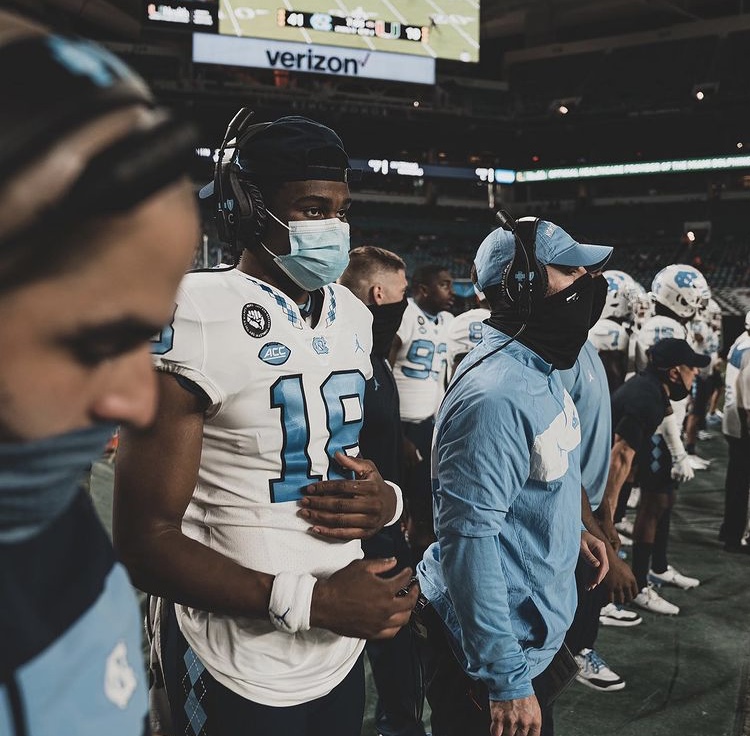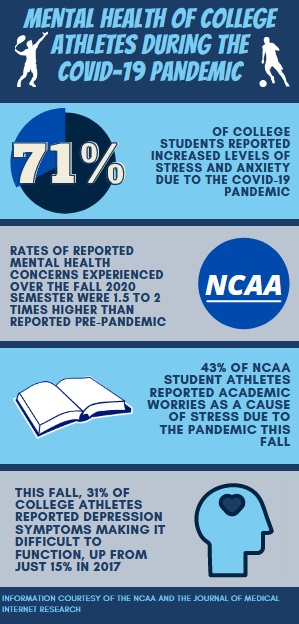
Mental Health of College Athletes During the COVID-19 Pandemic
By Freddy Stanley
In the summer and early fall of 2020, football fans were on edge wondering if there would be a college football season. Until late September, major conferences such as the Big Ten and the Pac-12 said they were not going to play, and other conferences were unsure if a season was able to be played. Fans were outraged that they might not have the chance to see their teams take the field in 2020, many of them calling for the season to go on at all costs. Eventually, to fans delight, all of the power 5 conferences elected to go on with their seasons in some way or another. The decision to play was applauded by many players but seemed reckless to others, with some players choosing to sit out the season due to safety concerns. When the games finally kicked off, what the viewers at home saw on TV wasn’t much different from what they see every year. But off the field, the players had to go through a season unlike any other.
During the summer, college athletes around the country left their homes and came to their respective campuses to enter team isolation bubbles. Once entering these bubbles, players were not allowed to interact with any unapproved outside personnel, making their teammates and coaches their only form of social interaction for months. While many people were concerned with the college football season contributing to the spread of COVID-19, other problems arose as a result of the season being played during a pandemic.

The year 2020 was taxing on the mental health of all college students. According to a study conducted by a team of researchers at Texas A&M, 71% of college students reported an increase in stress and anxiety due to COVID. Another study, conducted by a team of researchers at the University of North Carolina at Chapel Hill led by Jane Fruehwirth, found a 10% increase of mild to severe symptoms of depression in first year college students in 2020. Both studies point to feelings of social isolation and worries about COVID, among other factors, as main reasons for the decline of mental health of college students.
A study conducted by the NCAA provided evidence that athletes showcased this trend to an extreme. Through conducting an online survey of athletes across sports and divisions, the NCAA found a 52% increase in reported symptoms of depression as well as a 48.5% increase in reports of “overwhelming anxiety” from the last time they conducted the survey in 2017 to the study conducted in the fall of 2020.
There are many factors that have accounted for the decrease in mental health for athletes. General causes for mental health problems in athletes reported to the NCAA include academic worries, economic worries, and health concerns, but there are factors that are contributing to the decline in mental health that go beyond the surface. One of the main reasons for mental health decline during the COVID-19 pandemic has been identified by a study at the University of North Carolina at Chapel Hill. This study points to an increase in feelings of “social isolation” as one of the main causes for mental health problems during the pandemic. While feelings of social isolation are not exclusive to college athletes, the isolation that teams have been forced to go through for their season makes this a very relevant problem.
From mid-summer to the beginning of January, freshman Chris Holliday and the rest of the UNC football team were forced to isolate from the outside world, leaving their friends and family to exclusively interact with their teammates and coaches for months. “We’d get to the stadium at 6 a.m. and we wouldn’t leave the stadium all day, we would even do all of our classes here because they were all online. There was really no outside interaction,” said Holliday. Even while inside of the football center the players would still be forced to keep a mask on and stay six feet away from each other when at all possible.
Holliday is well aware of the social aspect of college life that he and his teammates missed out on by choosing to go on with the season. “When you get to college everybody talks about the social experiences you are supposed to have, and we were sort of denied those social experiences,” said Holiday. Although Holliday did experience aspects of social isolation as described by the Fruehwirth, he was able to socialize with his teammates and bond with them in a way no other team has in years past. “I was able to bond with my teammates. We spent a lot more time together because everybody was staying in and couldn’t go out. I think that during COVID we got a lot closer than we may have been.” said Holiday. Though the football season forced Chris to give up a lot, the social interaction he was able to have with his teammates proved to be a positive byproduct of COVID isolation.
This connection between teammates that Chris is referring to happens to be a solution to improving the mental health of college athletes. A study conducted by a team of researchers from the University of Washington looked at how teammate interactions correlated with mental health for college athletes during the COVID-19 pandemic. By tracking time spent socializing with teammates and comparing that to mental health levels, the study shows that the more connected athletes feel to their teammates, the better off their mental health will be. The data provided by the study suggests that college athletic programs make time and space for their players to socialize with their teammates during the pandemic, not only to promote team unity, but also improve mental health.
